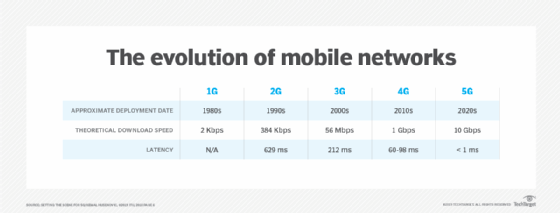4G (fourth-generation wireless) (original) (raw)
4G is the short name for fourth-generation wireless, the stage of broadband mobile communications that supersedes 3G (third-generation wireless) and is the predecessor of 5G (fifth-generation wireless).
The 4G wireless cellular standard was defined by the International Telecommunication Union (ITU) and specifies the key characteristics of the standard, including transmission technology and data speeds.
Each generation of wireless cellular technology has introduced increased bandwidth speeds and network capacity. 4G users get speeds of up to 100 Mbps, while 3G only promised a peak speed of 14 Mbps.

With 4G download speeds, wireless users can stream high-definition video and audio. 4G also enables wireless broadband, which provides a way for users to get internet connectivity without the need for a fixed, wired connection from an internet service provider (ISP).
How does 4G work?
At the most basic level, a 4G connection works via an antenna that transmits over radio frequencies, enabling mobile devices to connect to mobile networks.
The transmission and receiving capabilities of 4G are powered by MIMO (Multiple Input Multiple Output) and Orthogonal Frequency Division Multiplexing (OFDM) technologies. Both MIMO and OFDM enable more capacity and bandwidth in comparison to 3G. OFDM provides more speed than the primary technologies that powered 3G, which include TDMA (Time Division Multiple Access) and CDMA (Code Division Multiple Access) technology. With MIMO, 4G reduces network congestion in comparison to 3G, because more users can be supported.
4G is also an all-IP (internet protocol)-based standard for both voice and data, different from 3G, which only uses IP for data, while enabling voice with a circuit-switched network. As an all-IP network, 4G is more efficient for mobile network providers to operate and optimize than managing different network technologies for voice and data.
What is the difference between 4G and 4G LTE?
The difference between 4G and 4G LTE is all about marketing and the history of the 4G specification. LTE (Long Term Evolution) was originally developed to make the transition for carriers easier from 3G to 4G.
4G was first defined by the ITU in 2008, but its speeds and technical specifications were not immediately achievable for mobile networks or mobile devices. As an interim step up from 3G, LTE provides more bandwidth than 3G, without achieving the full bandwidth network speed minimum of 100 Mbps that 4G promises.
The term LTE is often used as part of marketing pitches and does not specify or imply a specific speed. Depending on the carrier, speeds range from 20 Mbps to 100 Mbps. 4G LTE-A (LTE-Advanced), however, is a specific term that is defined as enabling 100 Mbps. In effect, it is 4G, with no technical difference from it.
History of 4G
The earliest phases of what became known as 4G started in 2008 as the International Mobile Telecommunications-Advanced (IMT-Advanced) specification.
In 2008, no mobile network or cellular carrier was able to achieve the 100 Mbps speed that 4G specified, though there were competing approaches, including LTE and WiMAX (Worldwide Interoperability for Microwave Access), which aimed to bridge the gap between 3G and 4G.
Sprint was among the principal backers of WiMAX, while Verizon pushed LTE. A key difference between WiMAX and LTE is that WiMAX did not make use of OFDM, which became a foundational element of all production 4G deployments over time. By 2011, Sprint changed course and began to support LTE across its network, and WiMAX began to disappear.
LTE has steadily increased in speed and performance since 2011, with the 4G LTE-A technology providing cellular networks with the full 100 Mbps of network performance defined by the original IMT-Advanced specification.
The development and rollout of 4G's successor, 5G, is a multiyear process. As was the case with each prior generation, it takes multiple years to roll out a new generation of technology. The 5G rollout involves the use of new carrier technology and antennas, as well as mobile devices that support the new standard. All those efforts will take time to mature. Eventually at a date to be determined -- as was the case with 1G, 2G and 3G -- 4G networks will disappear in favor of the succeeding generations.
4G internet on the moon
A SpaceX rocket is expected to carry a 4G network to the moon in 2024, where it will land on the Shackleton Crater at the lunar south pole.
Setting up this cellular network is a joint venture between NASA and Nokia. The network will be powered by a base station stored in a Nova-C lunar lander that will connect to a rover.
NASA plans to use this 4G network in its Artemis program, which aims to return astronauts to the moon in the coming years. Humans have not been on the moon in more than 50 years.
Benefits of moving to 5G
5G is the next evolution of mobile network technology. It offers the promise of increased bandwidth with peak speeds as high as 20 Gbps, which is dramatically more than the 100 Mbps specified by 4G.
Bandwidth alone is not the only benefit of moving to 5G. Other benefits of 5G include:
- Lower latency. 5G enables more responsive, faster connections. 5G latency is intended to be less than 1 millisecond, which is significantly faster than the 60 to 98 milliseconds that 4G enables.
- Less congestion. 5G also offers less signal interference than 4G. Both 4G and 5G use OFDM technology, which splits signals into different channels. While 4G provides 20 MHz channels, 5G has channels in the 100 to 800 MHz range, enabling more capacity, less congestion and higher download speeds.
- Power consumption. For mobile devices, 5G has the potential to consume less energy on consumer devices and smartphones than 4G, which could enable longer battery life for devices.
This was last updated in April 2024
Continue Reading About 4G (fourth-generation wireless)
- The walking dead: Is there life left in 4G mobile networks?
- Learn the key differences between 4G and 5G networks
- Introduction to 5G: Your guide to fifth-generation wireless
- What is 6G and when will it come out?
- Best cell phone coverage 2021
 5G vs. 4G: Learn the key differences between them
5G vs. 4G: Learn the key differences between them  By: Michaela Goss
By: Michaela Goss  5G
5G  By: Alexander Gillis
By: Alexander Gillis  The essential 5G glossary of key terms and phrases
The essential 5G glossary of key terms and phrases  By: Kate Gerwig
By: Kate Gerwig  wireless broadband (WiBB)
wireless broadband (WiBB)